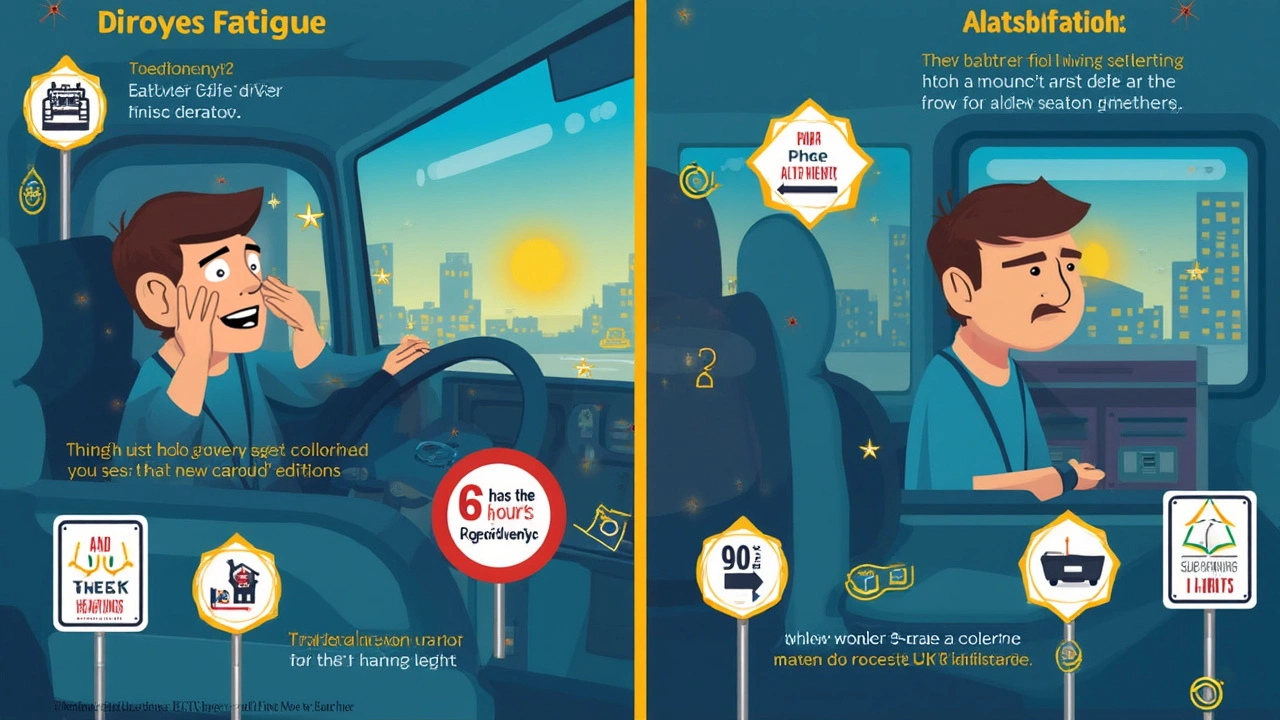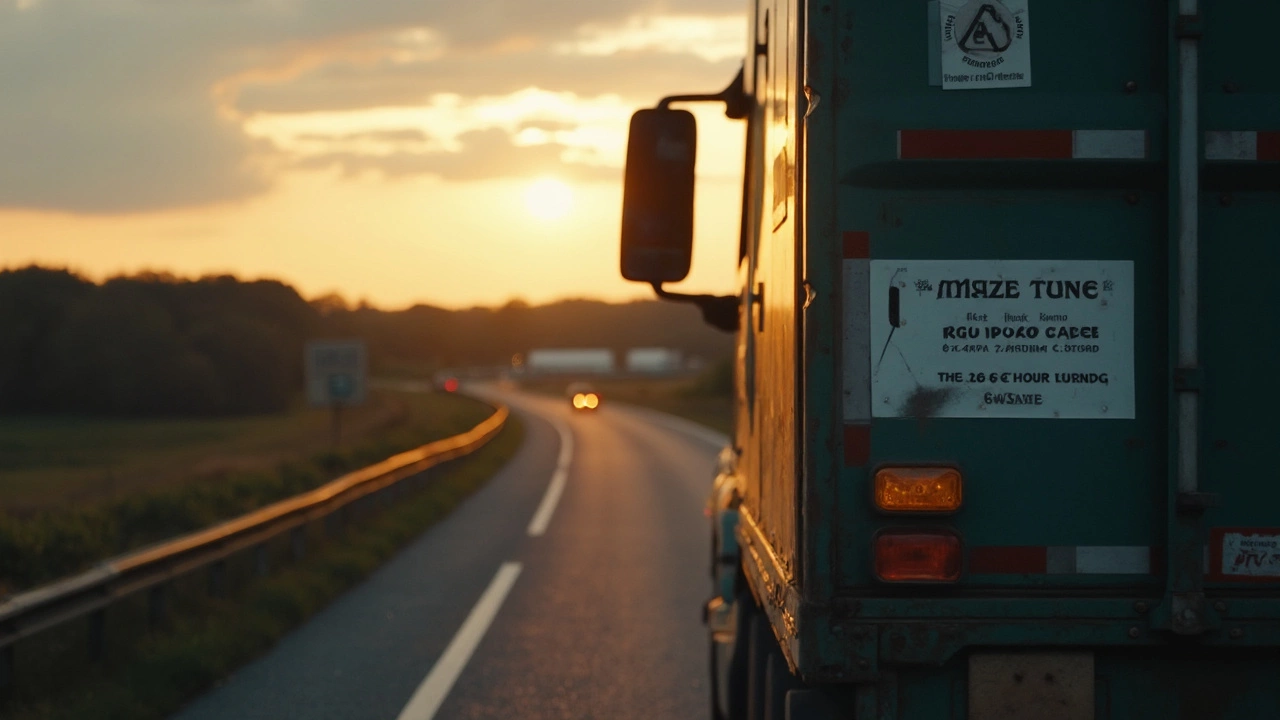Ever wondered why HGV drivers always talk about the 6 hour rule? It’s not just another bit of red tape—it can literally save lives. Here’s the deal: as an HGV driver, you can’t go more than six hours without taking a proper break. Simple, right? But there’s a catch. If you’re just starting out, keeping track of time on the road can be trickier than it sounds, especially with early mornings and long stretches of motorway.
The real reason for the 6 hour rule is driver fatigue. Let’s be honest, everyone thinks they can push through, but research shows that after six hours behind the wheel, reaction times drop and mistakes creep in. That’s why the law steps in where willpower runs out. Not following the rule can land you with heavy fines, points on your licence, and in the worst cases, you might even lose your job. So when that dashboard clock starts ticking close to the six-hour mark, it’s time to pull over. It’s about keeping yourself—and everyone else—safe.
- What is the 6 hour rule?
- Why is the rule so important?
- How does it affect everyday HGV driving?
- Common mistakes and how to avoid them
- Handy tips for sticking to the rule
What is the 6 hour rule?
The 6 hour rule is one of those things every HGV driver needs to know—no exceptions. It’s a strict legal limit in the UK, set out in the Working Time Directive, which says you can’t drive—or even just be on duty—for more than six hours without taking a break. This isn’t just a suggestion. It’s the law, and it’s enforced pretty seriously.
Simply put: after six hours on the job, whether you’re driving, unloading, or waiting to load, you need to take a break of at least 15 minutes. But if you’re approaching nine hours of duty, you need to take a second break. Miss these breaks and you’re risking more than a slap on the wrist.
- If your shift is up to 6 hours: Take one break of at least 15 minutes before you hit the 6-hour mark.
- If your shift runs longer (over 6 hours): Have a second break—at least another 15 minutes (bumped up to 30 minutes for over 9-hour shifts).
These rules are all about fighting fatigue, not making your day harder. Remember, it doesn’t matter if you feel fine—driver tiredness is sneaky and accidents spike when people skip breaks.
Here’s a quick look at how the 6 hour rule fits into the bigger picture for HGV driving:
| Maximum Duty Time | Minimum Break |
|---|---|
| Up to 6 hours | 15 minutes |
| 6 to 9 hours | 30 minutes (can be split into two 15 minute breaks) |
| Over 9 hours | 45 minutes (can be split but each chunk must be at least 15 minutes) |
The 6 hour rule works alongside other HGV rules, like daily driving limits and rest periods. They all add up to keep you alert, legal, and safe on the road. So next time you set off, don’t just check your mirrors—make sure you keep an eye on the clock too.
Why is the rule so important?
The 6 hour rule isn’t just some hoop to jump through on your way to a licence. It’s one of those rare rules where the reason is obvious as soon as you hit the road. Tired HGV drivers cause crashes—plain and simple. The government put this rule in place because studies have shown HGV drivers are more likely to make mistakes and cause serious accidents when they skip breaks. It’s about preventing dozing off or even just zoning out at the wheel. Trust me, you don’t want to go there.
Here’s a quote from the Health and Safety Executive, just to drive it home:
"Driver fatigue may be a contributing factor in up to 20% of road accidents, and up to one quarter of fatal and serious accidents on motorways and monotonous roads."
That’s not just a scary number—it’s a wake-up call. When you’re pushing a massive vehicle down the motorway, one bad decision can affect loads of other people, not just you. And it’s not just about crashes caused by falling asleep. After a few hours, even folks who feel okay start missing signs, misjudging speed, and taking risks they wouldn’t normally take. All because their brains are just worn out.
The rule also protects drivers from dodgy work practices. Maybe you could grind out eight, nine, or even ten hours without a break if the boss pushed you. Thanks to the 6 hour rule, you’ve got the law on your side. If you’re ever put in a spot where you’re asked to skip a break, you have a solid line you don’t have to cross.
It’s not just theory—check out how much impact it has. Look at this quick stat table based on real accident reports:
| Driving without break | Increased crash risk |
|---|---|
| 6 hours | x2 |
| 8 hours | x4 |
The 6 hour rule is a clear way to limit those chances. You protect yourself, your licence, your cargo, and everyone else traveling near you. No wonder it’s drilled into every HGV driving course from day one.

How does it affect everyday HGV driving?
The 6 hour rule shapes pretty much everything about a regular day if you’re driving an HGV for work. You can’t just power through with endless coffee and hope for the best. Instead, you have to plan your route, deliveries, and even fuel stops around those mandatory breaks. Sure, it sounds like a pain, but it builds structure into your shifts and keeps everyone safer.
Let’s get practical. Imagine you’re on a tight delivery schedule with five stops to make. If you’re not careful with your driving hours, you can easily blow past that six-hour limit just by getting stuck in traffic or spending extra time at a customer’s site. If you wait too long to take a break, you’re breaking the law—doesn’t matter if you’re only ten minutes away from the depot. Companies plan for this by setting up route management systems, but every driver still has to stay on top of their own time.
Here’s how the 6 hour rule fits into your day:
- You need to take at least a 15-minute break before you hit six hours of working—this includes all work, not just driving.
- If your shift is longer, you might need a longer or a second break, depending on your total hours behind the wheel or doing other duties.
- Tachographs (those little black boxes everyone talks about) log your driving hours and breaks, so there’s no way to fudge the numbers.
Take a look at this sample breakdown of a day to see how the rule fits in:
| Time | Activity | Break Required? |
|---|---|---|
| 6:00 - 8:00 | Driving | No |
| 8:00 - 10:30 | Unloading and paperwork | No |
| 10:30 - 10:45 | Break | Yes (before 6 hours up) |
| 10:45 - 13:00 | Driving & loading | No |
Messing up the timing means you’re risking fines or, worse, accidents. A lot of drivers use alarms or apps to remind them when breaks should happen, so there’s no excuse for losing track of time. Fact is, sticking to the HGV driving rules like this is part of being a pro—and your body and your boss will thank you for it.
Common mistakes and how to avoid them
Getting tripped up by the 6 hour rule isn’t rare, especially for new HGV drivers. Let’s break down the biggest mistakes out there and what you can do instead.
- Forgetting to track your hours: It sounds obvious, but when you’re focused on getting to your destination, it’s easy to lose track of time. Always use your tachograph properly. The number one reason drivers get fined is down to sloppy record-keeping.
- Taking breaks too late: Some drivers try to squeeze in a few extra miles before stopping. But leaving your break until last minute is risky. If you hit traffic or can't find a parking spot, you’ll break the rule before you know it. Plan your stops as soon as you start your shift.
- Misunderstanding what counts as a break: Scrolling your phone in the cab, refuelling, or doing paperwork doesn’t count. A real break means actually stepping away from all work tasks, even unloading or helping out at deliveries. For the HGV driving rules, only a proper rest—usually at least 15-30 minutes—counts.
- Relying only on memory: Never trust just your gut. A simple alarm on your phone or a dashboard reminder can be a lifesaver. The most careful drivers use tech to stay sharp.
Here’s a look at how often drivers slip up, according to a DVSA report from last year:
| Common Violation | % of Offenders |
|---|---|
| Lateness on breaks | 34% |
| Poor tacho records | 27% |
| Not taking full rest | 21% |
| Misunderstanding break rules | 18% |
Want to dodge these pitfalls? Stick to this simple checklist:
- Set an alarm for 5 hours in, so you always have time to find a stop.
- Double-check with your tachograph before and after breaks.
- Know the difference between real breaks and work tasks—if in doubt, step out!
- Keep your route flexible in case your planned stop is full.
Every seasoned driver has a story about a fine or a near miss. Play it safe and stay on the right side of the 6 hour rule so that story never has your name in it.

Handy tips for sticking to the rule
Following the 6 hour rule sounds simple, but when you’re in the cab, chasing delivery slots, it can slip through the cracks. Still, staying legal and safe is totally doable with a bit of planning. Here’s how to keep on top of those hours without the stress.
- Use a reliable digital timer or app: Most modern cabs come with a built-in tachograph, but having your own timer or driving hours app on your phone gives you backup. Set alarms so you know when you’re coming up to that six-hour mark.
- Plan your stops before you set off: Check your route and mark spots with safe parking and good facilities. This means you won’t get caught out on a stretch with nowhere to legally pull over, especially on unfamiliar roads.
- Don’t rely on memory: Records matter. The law says you need to log your breaks anyway, so keep a paper diary or use the digital system. If you’re stopped for a roadside check, you’ll have instant proof you’re playing by the book.
- Listen to your body: Even if the clock says you still have an hour, if you’re yawning or losing focus, take a break early. Research from the RAC shows drivers who feel even slightly tired are twice as likely to cause mistakes.
- Share the load if possible: Team driving can help. Tag teams are common on long hauls so each driver gets proper rest, cutting down the risk of skirting the 6 hour rule.
To see how much difference breaks can make, here’s a straightforward table—from a 2023 UK road safety report—showing the drop in accident risk for drivers who stuck to the 6 hour rule compared to those who didn’t:
| Break Taken Within 6 Hours? | Accident Risk Reduction |
|---|---|
| Yes | 70% |
| No | 30% |
Remember, sticking to your breaks is good for your record, your wallet, and your health. No delivery is worth risking your licence—or your life.

